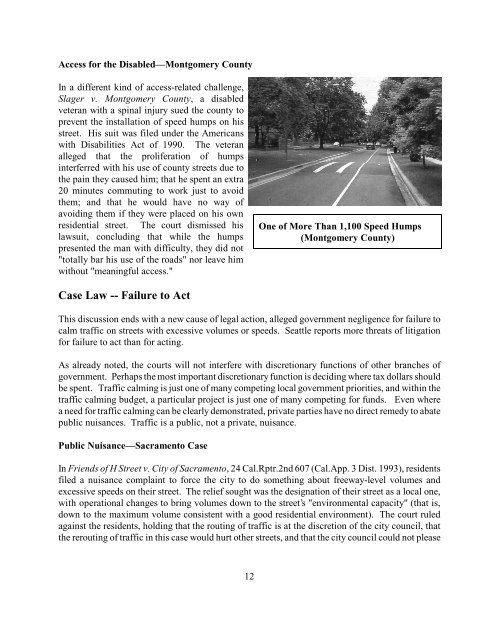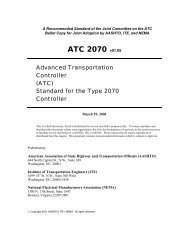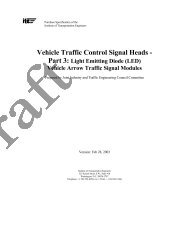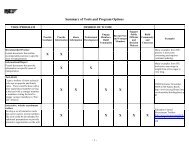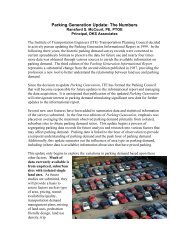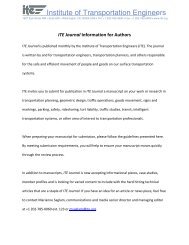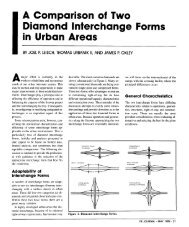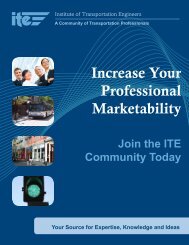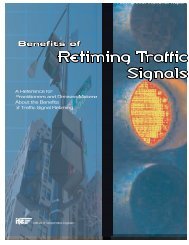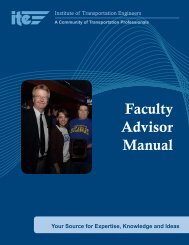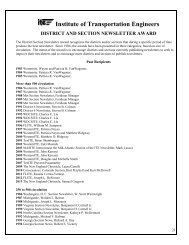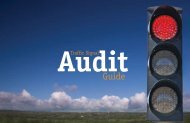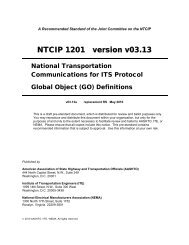Traffic Calming Liability Issues - Institute of Transportation Engineers
Traffic Calming Liability Issues - Institute of Transportation Engineers
Traffic Calming Liability Issues - Institute of Transportation Engineers
You also want an ePaper? Increase the reach of your titles
YUMPU automatically turns print PDFs into web optimized ePapers that Google loves.
Access for the Disabled—Montgomery County<br />
In a different kind <strong>of</strong> access-related challenge,<br />
Slager v. Montgomery County, a disabled<br />
veteran with a spinal injury sued the county to<br />
prevent the installation <strong>of</strong> speed humps on his<br />
street. His suit was filed under the Americans<br />
with Disabilities Act <strong>of</strong> 1990. The veteran<br />
alleged that the proliferation <strong>of</strong> humps<br />
interferred with his use <strong>of</strong> county streets due to<br />
the pain they caused him; that he spent an extra<br />
20 minutes commuting to work just to avoid<br />
them; and that he would have no way <strong>of</strong><br />
avoiding them if they were placed on his own<br />
residential street. The court dismissed his<br />
lawsuit, concluding that while the humps<br />
presented the man with difficulty, they did not<br />
"totally bar his use <strong>of</strong> the roads" nor leave him<br />
without "meaningful access."<br />
One <strong>of</strong> More Than 1,100 Speed Humps<br />
(Montgomery County)<br />
Case Law -- Failure to Act<br />
This discussion ends with a new cause <strong>of</strong> legal action, alleged government negligence for failure to<br />
calm traffic on streets with excessive volumes or speeds. Seattle reports more threats <strong>of</strong> litigation<br />
for failure to act than for acting.<br />
As already noted, the courts will not interfere with discretionary functions <strong>of</strong> other branches <strong>of</strong><br />
government. Perhaps the most important discretionary function is deciding where tax dollars should<br />
be spent. <strong>Traffic</strong> calming is just one <strong>of</strong> many competing local government priorities, and within the<br />
traffic calming budget, a particular project is just one <strong>of</strong> many competing for funds. Even where<br />
a need for traffic calming can be clearly demonstrated, private parties have no direct remedy to abate<br />
public nuisances. <strong>Traffic</strong> is a public, not a private, nuisance.<br />
Public Nuisance—Sacramento Case<br />
In Friends <strong>of</strong> H Street v. City <strong>of</strong> Sacramento, 24 Cal.Rptr.2nd 607 (Cal.App. 3 Dist. 1993), residents<br />
filed a nuisance complaint to force the city to do something about freeway-level volumes and<br />
excessive speeds on their street. The relief sought was the designation <strong>of</strong> their street as a local one,<br />
with operational changes to bring volumes down to the street’s "environmental capacity" (that is,<br />
down to the maximum volume consistent with a good residential environment). The court ruled<br />
against the residents, holding that the routing <strong>of</strong> traffic is at the discretion <strong>of</strong> the city council, that<br />
the rerouting <strong>of</strong> traffic in this case would hurt other streets, and that the city council could not please<br />
12


